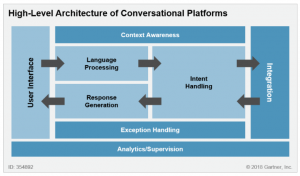Conversational AI Platform
--> to the BOTwiki - The Chatbot Wiki
Conversational AI Platforms, also called Conversational Platform, Conversational Middleware, are software systems that can be used to create and operate virtual assistants and conversational user interfaces for a wide range of applications. Furthermore, they enable integration into chat interfaces such as messenger services, social media, SMS and chats on websites. A conversational platform usually has a developer interface (API) so that third parties can extend the platform with their own customisations. [1]
The terms Conversational AI Platform and Conversational Platform are not clearly defined scientifically. Rather, they are services or platforms that use Natural Language Processing (NLP) as a basic technology and thus make conversational interfaces of various kinds possible.
Functional Areas
In order to enable companies to develop and successfully operate chatbots and to constantly adapt them to the needs of the users, a suitable conversational platform must cover many different functional areas. This is the processing of natural language, integration possibilities and functionalities to operate the virtual assistants. A common architecture of the current Conversational Platforms is shown in the following figure. [1]
Source: Gartner - Market Guide for Conversational Platforms [1]
Natural Language Processing
Currently, the Conversational AI Platform providers are focusing on the functional area NLP and thus on the interpretation and processing of natural language and the provision of a suitable response for the user. Successful providers in this area are Google with Dialogflow, Microsoft with LUIS, IBM with Watson, Amazon with Lex and Rasa with its open source solution. This type of system usually covers only a subarea of a conversational platform and is also referred to as an NLP service. Many of these services are SaaS (Software as a Service) solutions provided in conjunction with their own cloud solutions. [1]
Integrations and Middleware
As technology continues to evolve, companies demand standardized and flexible integrations. On the one hand, simple and intelligent integrations in messenger interfaces such as WhatsApp, Facebook Messenger, Slack, Microsoft Teams, SMS and web chats are made possible. On the other hand, standardized integrations in enterprise software such as SAP, Salesforce, Hubspot, G Suite, Outlook, Workday, etc. are becoming increasingly important in order to optimally integrate chatbots into the business processes of companies. It is assumed that the market for Conversational Platforms will be divided in the future into vendors that focus mainly on Natural Language Processing and vendors that focus on simple integration possibilities and functionalities for the operation of chatbots. [1]
Functions in the Chatbot Operations
Supplementary functionalities, which enable chatbots in companies to be successfully operated, maintained and continuously developed, are becoming increasingly important. The reason for this is that the task of operating chatbots is gradually being shifted away from the IT departments to individual specialist departments. This makes simple and intuitive user interfaces necessary.
Some examples of these functionalities are:
- Human handover tools that allow chatbots and human agents to work together to answer customer queries.
- Simple Conversation Editor systems, which allow IT laymen to easily customize the content of chatbots.
- Analytics Tools to measure the performance of chatbots and better tailor content to customer needs.
- Training tools to constantly increase the knowledge base of chatbots so that they can provide appropriate answers to more requests.
- Libraries of pre-built intents (questions and answers) and processes for a wide variety of applications and industries, enabling you to create chatbots very quickly and easily.
Scalability and Flexibility
To build a holistic, scalable and long-term viable Conversational AI Platform, many companies are currently developing their own Conversational Middleware platforms. These platforms enable the connection of different services and software systems in such a way that all necessary functional areas are sufficiently covered and the used services can be easily exchanged. With this approach, companies will have the possibility to integrate new and more efficient services into their chatbot architecture. Outdated and too cost-intensive services can be eliminated. Thus, companies will always be up to date. [1]
BOTfriends X - The Conversational Middleware Platform
- Use only one platform for all different Conversational AI projects in the company
- Departments are enabled to manage the conversational content in an easy to use editor with user management
- Easily switch between established Natural Language Processing Services such as Google Dialogflow, IBM Watson Assistant and Microsoft LUIS
- Deploy your application on a lot of different channels such as messaging platforms, voice assistants or telephone
> Learn more about BOTfriends X
> Back to BOTwiki - The Chatbot Wiki

